 |
|
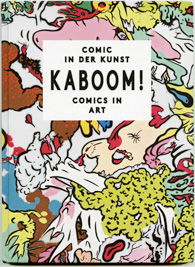
kaboom! catalog, weserburg museum, 2013
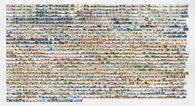
land of black gold iv, weserburg museum
|
COMICS
Weserburg | Museum für Moderne Kunst, Bremen, Gemany, 2013
curated by Ingo Clauß, Peter Friese, Guido Boulboullé
June 15 - October 6, 2013
Comic strips and cartoons have been a constant source of inspiration for artists since the very beginning. But it was only with British and American Pop Art that the world of speech balloons made its grand entry into galleries and museums. Roy Lichtenstein, Öyvind Fahrström, and many other artists introduced the aesthetic of comics into their paintings. In this way, they provocatively undermined the distinction between popular culture and established art. The Weserburg is taking up this theme with a large-scale exhibition. On display are works by more than thirty international artists. They offer an impressive demonstration of the influence of comics on contemporary art from the nineteen-fifties until today.
Particular emphasis is being given to the works of a younger generation of artists. They bear witness to the contemporaneity and innovative energy which today still emanates from an involvement with comics. These works make use of the visual worlds and formal peculiarities of comics in an exciting and unusual manner. Transcending genres, the artists work with paintings, collage, video, and drawings, as well as creating sculptures and space-encompassing installations. In so doing, they do not reproduce a supposedly naive and cheerful surface. Instead, they conduct a critical investigation of aesthetic and social phenomena, and this frequently occurs with wittiness, humor, and biting irony.
The invited artists take up familiar motifs and narratives of comics which they process, deconstruct, and reassemble in a new shape. Many of the works are from time to time disturbing psychograms of society with surprising, subversive-political allusion. With deliberate reference to comics, art accordingly attains new forms of visual expression; it becomes the site of special aesthetic experiences and recognitions.
Sourced from the Weserburg Museum website.
For more information visit the Weserburg Museum website.
KABOOM! COMICS IN ART
curated by Ingo Clauß, Peter Friese, Guido Boulboullé
Weserburg Museum für Moderne Kunst, 2013
Siemon Allen (ZA), Martin Arnold (A), Dara Birnbaum (USA), Peter Blake (GB), William Copley (USA), Reinhard Doubrawa (D), Erró (IS), Öyvind Fahlström (SE), Gerard Hemsworth (GB), Arturo Herrera (VE), Andy Hope 1930 (D), John Isaacs (GB), Bertrand Lavier (FR), Mark Leckey (GB), Roy Lichtenstein (USA), Michel Majerus (LU), Christian Marclay (USA), Kerry James Marshall (USA), Matt Mullican (USA), Juan Muñoz (ES), Rivane Neuenschwander (BR), Chris Ofili (GB), Joyce Pensato (USA), Raymond Pettibon (USA), Sigmar Polke (D), William Pope.L (USA), Mel Ramos (USA), Allen Ruppersberg (USA), Francesc Ruiz (ES), Keiichi Tanaami (J), John Wesley (USA), Sue Williams (USA), Jordan Wolfson (USA).
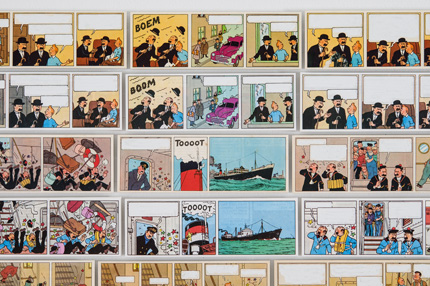
Land of Black Gold IV, 2004
cut-up comics, foam board, correction fluid
photo by Terry Brown
|
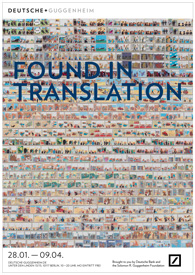
poster, deutsche+guggenheim, berlin, 2011
|
Deutsche + Guggenheim, Berlin, 2012
curated by Nat Trotman
January 1 - April 9, 2012
In our globalized world, with political, economic, and social issues intertwined across national boundaries, translation has become a fundamental tool, both linguistically and more figuratively, in making sense of reality. Taking this concept as a model and a metaphor, Found in Translation brings together recent works that investigate the ways cultural difference is negotiated through written or spoken text. Through videos, installations, photography, and other media the artists in this exhibition explore intersections of language, politics, history, and fantasy, critically commenting on the past while producing richly imagined possibilities for the present.
For the exhibition Found in Translation, the German Guggenheim in Berlin has selected nine artists whose works are concerned with language and with the translation of one language into another, of the past into the present, and of reality into art. Represented are Siemon Allen, Alejandro Cesarco, Patty Chang, Keren Cytter, Brendan Fernandes, Sharon Hayes, Matt Keegan, Lisa Oppenheim and O Zhang.
|
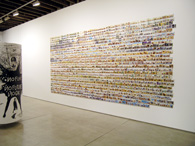
land of black gold iii, pop-agenda, fusebox
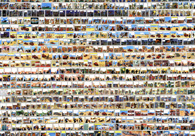
land of black gold, art positions, miami, 2003
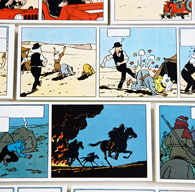
land of black gold, detail, 2003
All text frames are 'whited-out' with correction-fluid making dialogue open to interpretation and speech bubbles overtly part of the aesthetic pattern.
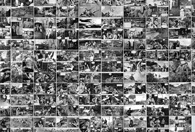
naglegioen, pop-agenda, fusebox, 2004
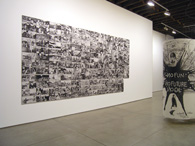
naglegioen, pop-agenda, fusebox, 2004
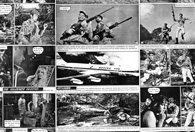
naglegioen, detail, 2004
|
POP-AGENDA, Fusebox, Washington, DC, 2004
Dominic McGill & Siemon Allen
POP-AGENDA
by Dominic Rushe
Siemon Allen and Dominic McGill are both artists who have chosen America as their home, and whose work looks at popular culture and political agendas both here and in their home countries. Much of South African-born Allen's recent work has involved some form of appropriation: a massive South African stamp collection, US newspapers and collector's cards have been used to examine ideas including nationhood and propaganda. Language, history and politics
also fuel the work of Dominic McGill. In his last solo show, British-born McGill built a rusting atomic bomb that contained a lifelike model of the Bikini Atoll. His large scale drawings have also looked at recent American history.
In his latest work, Allen has used two of Herge's classic Tintin adventures—" Land of Black Gold" and "The Red Sea Sharks;" and a South African photo-comic from the 1970s called "Naglegioen" - Night Legion in Afrikaans. Allen uses the Tintin adventures to take a timely look at Western attitudes toward the Middle East and Arab culture. Tintin's Middle Eastern adventures have a complex history. In the original version, Tintin was arrested by the British authorities in Haifa, and subsequently kidnapped by Jews and then by Arabs. By its final English language revision, Herge has depoliticised the book, excising all references to the British and Jews and setting the story instead in his imaginary emirate of the Khemed. Allen has spliced the versions, high-lighting Herge's self-censorship and our own changing attitudes.
"Naglegioen" is a more overtly political work, set in Angola in the1970s. Allen unearthed the "Naglegioen" in a Durban comic store. South Africa's answer to the A-Team, the naglegioen are mercenaries who conduct covert operations for "millionaires, statesmen and leaders" - in this case rescuing the daughter of the local governor. Like the British presence in Haifa, the Portuguese had troops stationed in Angola to protect their colonial interests and to fight rebels who were
seeking independence. In the familiar Tintin images, Allen has blanked out the speech bubbles, leaving space for the viewer to create his own narrative. In Naglegioen, the speech remains but is unintelligible for most American viewers.
[...]
Both artists' pieces seem to warn us that our agendas and the forces that shape them are difficult to read and ever changing, and that the search for the truth is a perilous journey: Allen's piece ends with Tintin lost at sea, McGill's history leads to a burning forest.
Dominic Rushe is a New York-based US correspondent for The London Sunday Times.
from the invitation essay published by Fusebox, 2004
|
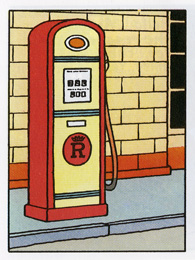
herge's first frame in " land of black gold"
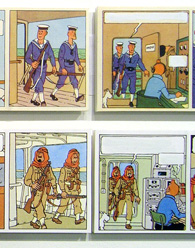
lobg (edit), detail, richmond, 2006
right:
land of black gold ii, the project, la, 2004
The image to the right shows the second version of the installation: Land of Black Gold. The two versions of the comic story are placed parallel to each other but in counterpoint. Red numbers indicate the lines of the 1955 version while black numbers indicate the altered 1972 version. Green numbers indicate the parts of "The Red Sea Sharks" that were used to end the story. Because the altered version has significant changes in the story, the overall effect shows a pattern going out of sync.
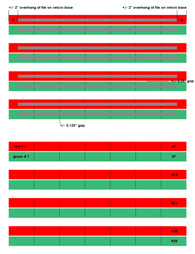
land of black gold , installation diagram
The red lines represent the frames taken from the 1955 version of "Land of Black Gold"
while the green lines represent those from the 1972 version.
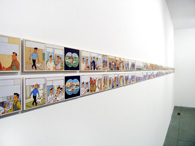
lobg (edit), richmond, 2006
This version of the piece was an experiment placing only the altered frames in two concurrent lines.
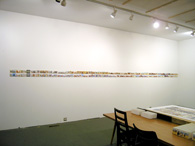
lobg (edit), richmond, 2006

land of black gold, detail, 2003
|
LAND OF BLACK GOLD, 2003
by Siemon Allen
Land of Black Gold was first exhibited in 2003, one year after the United States’ invasion of Iraq and three years after September 11th. These events brought the Middle East to the forefront of media coverage and at that time I had begun to consider how a collection of comics from my youth—the stories of Herge’s journalist hero Tintin—had constructed an ‘Arab image’ for me and for the western reader. I had worked with my Tintin comic collection in an earlier work, Pictures and Words (1998), reassembling cut-up scenes and scrambling the dialogue in the original comic with texts from a diverse range of sources including newspaper articles and theory books. There I had engaged the little colonial adventurer as a kind of alter ego, forcing the cut images and bits of the original text into a kind of dialogue with the reading material that had come across my desk from daily periodicals to textbook essays. However, my interest in a Tintin story set in the Middle East led me to revisit the comic in a different way with Land of Black Gold.
In the very first frame of “Land of Black Gold” Herge introduces the story with an image of a petrol/gas dispenser, and as the plot develops unnamed foreign powers seek to gain control of the Middle East and weaken the West by sabotaging oil supplies. Indeed, as far back as 1939 when the first version of the “The Land of Black Gold” appeared in the newspaper Le Vingtieme Siecle, the connection between oil, the Middle East and its importance to the West had been evident.
Land of Black Gold was constructed by cutting up the original comics and individually mounting each frame on foam-core. Three Tintin comics are used: “Land of Black Gold” (1955 version), "Land of Black Gold” (1971 version), and “The Red Sea Sharks” (1958), which could be interpreted as a sequel to “The Land of Black Gold”. These frames were configured into a grid integrating the two versions of “Land of Black Gold” into two parallel lines with “The Red Sea Sharks” as an add-on.
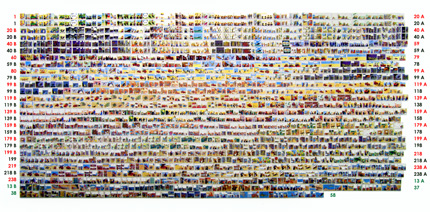
At the beginning the stories in the two versions are virtually identical, and so the two rows are ‘in synch’. (This is evident in the top two rows.) However, as the story progresses the parallel stories begin to go ‘out of synch’, and the regular pattern initially seen at the top begins to become more complex. This occurs because the later version of the story was re-drawn with many frames altered and removed. The ‘erasure’ that happens from one version of the Tintin comic to the next causes this pattern shift in the grid.
This erasure is significant in that there were four versions of the comic, and these changes reflect shifts in the political climate in the Middle East and in the West. (The first version was drawn between 1939 - 1940 and subsequent versions in 1948, 1950 and 1971.) At the request of the British Publishers, the British Palestinian Mandate forces were replaced in later versions by Arab military police. In almost identically drawn scenes, we see in the place of the kilted British soldiers of the 1940 version, two Arab military policemen. Other scenes were eliminated and the events truncated after the first version. For example, Tintin no longer arrives in British-occupied Palestine, is no longer arrested by British soldiers and is no longer kidnapped by the Irgun (the Jewish militia, who in the first version let off a gas grenade and bundle Tintin into their car having mistaken him for their own.)
Interestingly, many of the characters in the story reference specific individuals. Perhaps the most notable is the character of Abdullah, the King’s spoiled son, who causes no end of trouble to Tintin, The principal inspiration for this character was Faisal II, who became king of Iraq in 1939, just when Hergé began to work on the story. (Among Herge’s papers was a photograph of the young Faisal, which he copied in every detail for the Abdullah character.) Other frames show images that seem remarkably resonant with current events in the Middle East and prevailing attitudes. In one particularly graphic image, a Tintin regular, one of the Thompson twins kicks an Arab man from behind while he is praying. All the text has been erased in the artwork so that his motive is mysterious, but the image is provocative. In the story the Arab man has been mistaken for a mirage.
From a distance these images in individual frames are reduced to patches of color and The Land of Black Gold resembles a large abstract painting - the color shifts that result when the two stories go ‘out of synch’ creating a kind of expressive gesture in the pattern. For me, this is not so unlike the layering that is constructed in a Steve Reich sound work (Come Out, 1966), where a small shift in a repeated phrase becomes amplified, creating new patterns with each overlay. I produced a number of works that operated in much the same way.
One such work, Naglegioen (2004), was a large grid made with cut up South African ‘photo comics’. These curious artifacts, popular in the late 1960s and 1970s featured individual photographs of actors posed in mini tableaus. The story was told through exaggerated melodramatic gestures along with speech and thought bubbles. The language of the text, Afrikaans, was incomprehensible to most audiences outside South Africa. Like Land of Black Gold from a distance, Naglegioen too becomes an abstract image of shifting grey tones.
The last frames in Land of Black Gold are truncated scenes from “The Red Sea Sharks.” They show Tintin lost at sea on a burning ship.
Siemon Allen, 2004
|
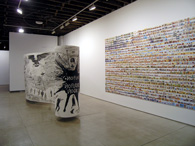
pop-agenda, fusebox, 2004
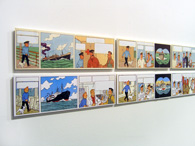
lobg (edit), richmond, 2006
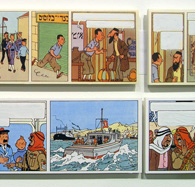
lobg (edit), detail, richmond, 2006
The upper frames show some of the anti-semitic imagery that was later removed.
|
REVIEWS: SIEMON ALLEN/ DOMINIC MCGILL
by
Howard Risatti
Artforum, Summer 2004
[extract]
Clearly inspired by events in the Middle East, the works by Dominic McGill and Siemon Allen that make up the recent show "Pop Agenda" use a pop-cultural idiom to offer a glimpse of how political, economic, and social issues get transformed as they percolate through mass media and culture. [...]
Allen, on the other hand, takes his political imagery straight and uneditorialized. On the walls flanking McGill's drawing, the South African artist, who now lives in Richmond, Virginia, installed what at first appeared to be two large, gridded abstractions but which are actually the pages of comic books he read as a youth, laid out in a grid. Naglegioen ("Night Legion" in Afrikaans), 2004, measures approximately seven by fourteen feet and reproduces a black-and-white photo-comic from the '70s that tells the tale of South African mercenaries in Portuguese-controlled Angola trying to rescue a local governor's daughter from mutinous colonial forces. Because all the participants look alike and the Afrikaans-language text is untranslated, it's impossible for an American viewer to tell heroes from villains, and one is left to ponder the nature of aggression and violence itself. On the opposite wall is Land of Black Gold, 2004, another giant at seven by sixteen and a half feet, which takes apart a still painfully current 1950 Tintin comic about colonialism and Middle East oil. The original French-language edition of the comic book and its 1971 British translation are aligned in parallel rows with all text removed from the panels to show how its British translators and publishers transformed the later version, not only entirely expunging anti-Jewish images and all depictions of the British Navy and British Mandate forces in Palestine, but actually changing the setting to a fictional Middle Eastern emirate called Khemed. Gradually, with scenes redrawn, truncated, or eliminated so as to project a more politically expedient story, the two editions get further and further out of sync. Like McGill's technique of puncturing wide-screen panoramic effects with graffiti and text. Allen's shifting frames make the changes in Western political attitudes toward the Middle East palpable and visible; they also raise our awareness of the way seemingly innocuous sources can quietly manipulate our understanding of history.
Howard Risatti, Artforum, Summer 2004
|
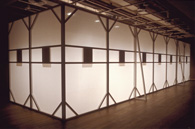
pictures & words, stockholm, 1998
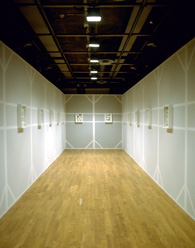
pictures & words, stockholm, 1998
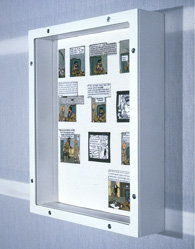
pictures & words, detail, 1998
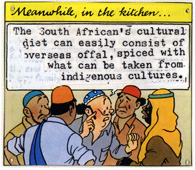
pictures & words, detail, 1998
|
PICTURES & WORDS, 1998
Vita Art 98, Sandton Civic Gallery, Johannesburg, South Africa
Drömmar och Moln, Kulturhuset, Stockholm, Sweden
VITA ART 98
by Brenda Atkinson
Electronic Mail & Guardian, August 1998
[extract]
Durban-born, 27-year-old Siemon Allen lives in Washington DC, but maintains an active and compelling presence within the South African art world. His most recent contribution to local shores was an impressive and provoking work on Graft, curated by Colin Richards for the Second Johannesburg Biennale. Allen’s work - consisting of a "faux gallery" with walls made of woven video-tape - was installed in the entrance to the South African National Gallery. Reflecting the quiet menace of Jane Alexander’s Butcher Boys, the work recontextualized the objects within the gallery, interfering with any direct reading of the space or its contents. The device of the "room within a room" is the conceptual mainstay of Allen’s work, and his Vita piece, titled Pictures and Words, continues this thematic. Consisting of white sheets stretched onto wooden frames, this mini-gallery houses a series of found cartoon strips mounted in box frames. By reworking the images and text of Tintin cartoons, and intercutting these with fragments of other comics, Allen delivers a tightly conceived, brilliantly constructed anti-narrative that sends up high-theoretical notions of colonialism, apartheid, "African art", the gaze, feminist psychoanalysis, and the Society of the Spectacle. It’s a wicked "post-historical adventure" that shifts and recodes familiar objects, images, people, and perceptions, with the aim of détourning their social significance.
Brenda Atkinson, Electronic Mail & Guardian, August, 1998 [extract]
VITA ART 98
curated by Natasha Fuller
adjudicated by Okwui Enwezor, Bongi Dhlomo, Frank Ledimo, Kendell Geers
Sandton Civic Gallery, Johannesburg, South Africa, 1998
William Kentridge, Moshekwa Langa, Stepen Cohen, Sandile Zulu, Lisa Brice, Siemon Allen
DRöMMAR OCH MOLN
curated by Ingemar Arnesson
Kulturhuset, Stockholm, Sweden, 1998
Sandile Zulu, Sue Williamson, Konrad Welz, Johannes Segogela, Jo Ratcliffe, Albert Munyai, Zwelethu Mthetwa, Santu Mofokeng, Ledelle Moe, Hentie van der Merwe, Isolde Krams, William Kentridge , Maureen de Jager, Kevin Brand, Willem Boshoff, Clive van den Berg, Siemon Allen
|
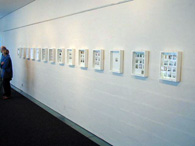
pictures & words, nsa gallery, durban, 2000
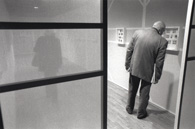
pictures & words, stockholm, 1998
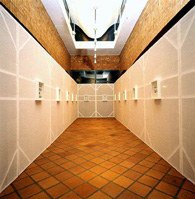
pictures & words, vita 98, johannesburg, 1998
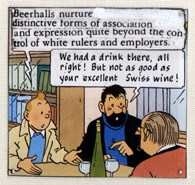
pictures & words, detail, 1998
|
PICTURES & WORDS (edit), 2000
Open Circuit , NSA Gallery, Durban, South Africa
curated by Greg Streak
Pictures and Words is in many ways a continuation of previous explorations where common items from different stages of my youth were presented as 'artworks'. These included a set of Hardy Boys books, a South African stamp collection and a pair of Doc Marten shoes - the context of these objects shifted to expose hidden meanings. The act of displacing these non-precious items allowed for an examination into the value of such cultural icons and the information encoded in these seemingly ordinary things. The vicarious nature of the adventures in the comics or detective stories, the implicit propagandistic intent of artifacts presenting a country's image of itself in the stamp collection, or the recognition of the constructed identities embodied in the coveted brand name products were all explored through simple framing in a display box. In Pictures and Words I again used this device of the 'displayed artifact' to isolate and present the re-contextualized 'artifact', but in this case with a constructed object masquerading as a found object. Each 'specimen' was created with mass produced multiples, including a childhood comic collection, theory books, and newspapers, which had been physically cut up and recombined. The work owes much to poetry production strategies that employ the 'cutup' method to break open language. But the 'cutups' in his case were, for me less an effort to tap into the unconscious, than, in the spirit of détournement, a collision of seemingly incompatible texts - comic and the theoretical. In this way, I set out to expose the political in popular humour and the humour in theory. The central role of the tintin character was also significant, for not only was he a childhood favourite, but also in many ways a very particular kind of alter ego. Now regarded critically, he was an adventurous little colonial sliding unscathed from adventure to adventure the 'exotics', a backdrop for his story.
Siemon Allen, 2000
from the publication Open Circuit by Greg Streak
published by Pulse, 2000
OPEN CIRCUIT
curated by Greg Streak
NSA Gallery, Durban, South Africa, 1998
Siemon Allen, Mark Bain, James Beckett, Andries Botha, Kendall Buster, Isaac Carlos, Jose Ferreira, Stephen Hobbs, Robin Rhode, Shamila Samant, Kathryn Smith, Greg Streak, Jeremy Wafer
|
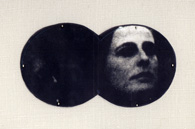
pictures & words (edit), washington, 2002
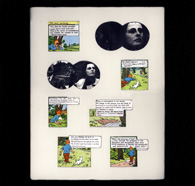
pictures & words (edit), washington, 2002
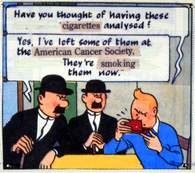
pictures & words, detail, 1998
|
PICTURES & WORDS (edit), 2002
Cultural Crossing, Numark Gallery, Washington DC, 2002
curated by Paul Brewer
WHERE VISAS ARE NOT NEEDED
by Jessica Dawson
The Washington Post, April 11, 2002
[extract]
There are no clear winners in South African-born Siemon Allen’s clever collages. The artist inserts phrases culled from newspapers and academic texts into panels from Tintin cartoons. His collages are a smart sendup of colonialism. Young white Tintin, star of the still-popular Belgian comic books from the 1930s and '40s, traveled the world—Africa, the Soviet Union, North and South America—winding up in un-PC scenarios. In Allen’s hands Tintin's colonialist leanings get magnified to laughable corporations. But so, too, does post-colonial theory.
In four pieces at Numark, Allen stuffs Tintin's word bubbles with decidedly un-cartoonish dialogue. Gesturing to a locomotive wreck behind him, Tintin addresses a group of blacks with "Tragedy begins when things leave their accustomed place, like Europe." A well-dressed African woman, annoyed with her assigned role as second-class citizen, retorts, "Apparently, our ‘post-historical’ adventure doesn’t differ much from a Spaghetti Western."
In another panel a character utters a paragraph of post-colonial text that would make the most arcane theorist proud. Dogma, when uttered by cartoon characters, deflates rather rapidly.
Jessica Dawson, The Washington Post, April 11, 2002
CULTURAL CROSSING
curated by Paul Brewer
Numark Gallery, Washington, DC, USA, 2002
Siemon Allen, Shimon Attie, Chan Chao, Alfredo Jaar, Zwelethu Mthethwa, Mick O'Shea, Michal Rovner, Yukinori Yanagi
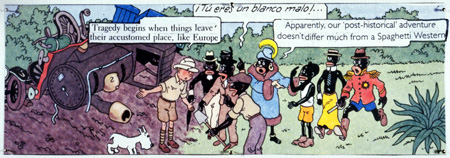
|
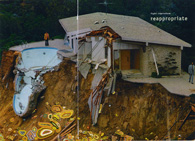
renewed appropriations invite, the project, la
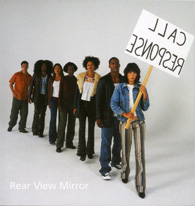
rear view mirror, kettle's yard, cambridge

pop-agenda invite, fusebox, 2004

kaboom! catalog, weserburg museum, 2013
|
EXHIBITION HISTORY
VITA 98
curated by Natasha Fuller
Pictures & Words
1998
Sandton Civic Gallery, Johannesburg, South Africa
DRöMMAR OCH MOLN (DREAMS & CLOUDS)
curated by Ingemar Arnesson
Pictures & Words II
October 3, 1998 - January 10, 1999
Kulturhuset, Stockholm, Sweden
OPEN CIRCUIT
curated by Greg Streak
Pictures & Words (edit)
October 27 - November 23, 2000
NSA Gallery, Durban, South Africa
CULTURAL CROSSING
curated by Paul Brewer
Picture & Words (edit)
April 5 - May 4, 2002
Numark Gallery, Washington, DC, US
ART POSITIONS
Art Basel/Miami Beach 03
Land Of Black Gold I
December 4 - 7, 2003
Fusebox at ART POSITIONS, Miami, FL, USA
NOTES ON RENEWED APPROPRIATIONS
Curated by Lauri Firstenberg
Land Of Black Gold II
March 13 - April 24, 2004
The Project, Los Angeles, CA
Collection of the Guggenheim Museum, NY
POP-AGENDA
Two-person exhibition with Dominic McGill
Land Of Black Gold III
March 27 - May 8, 2004
Fusebox, Washington, DC
REAR VIEW MIRROR
Curated by Elizabeth Fisher
Land Of Black Gold IV
September 18 - November 7, 2004
Kettle’s Yard, Cambridge, UK
FOUND IN TRANSLATION
Curated by Nat Trotman
Land Of Black Gold II
January 28 - April 9, 2012
Deutsche + Guggenheim, Berlin, Germany
KABOOM! COMICS IN ART
Curated by Ingo Clauß, Peter Friese, Guido Boulboullé
Land of Black Gold IV
June 15 - October 6, 2013
Weserburg | Museum für Moderne Kunst, Bremen, Germany
|


































